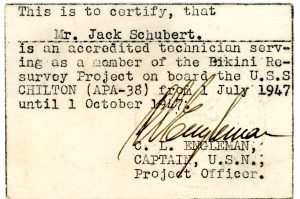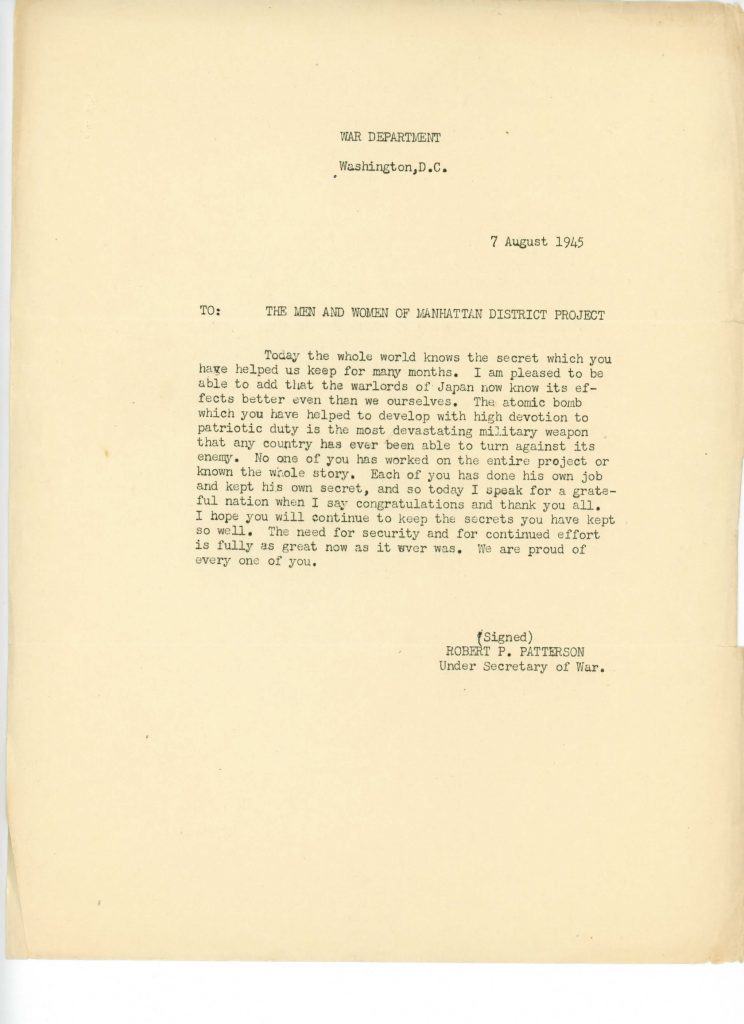Jack Schubert was an American chemist and Manhattan Project scientist. Schubert was born on September 14, 1917 in Chicago, Illinois. He graduated from the University of Chicago in 1940, and in 1944, earned his Ph.D. in Chemistry.
In 1941, George E. Boyd invited Schubert to conduct secret nuclear research at the University of Chicago. Shortly after, he joined the Metallurgical Laboratory as a research chemist. In 1943, Schubert and the Met Lab plutonium absorption team were transferred to Oak Ridge, where they remained until March of 1945. This team focused on analyzing uranium oxide ore and on devising methods for removing impurities. They also worked on methods to extract and separate plutonium from irradiated uranium and fission products. In 1945, the team returned to the University of Chicago to conduct research on the effects of radiation.
In 1947, Schubert conducted radiochemical reports on the effects of nuclear testing radiation at Bikini Atoll in the Marshall Islands, for the U.S. Navy. Over his career, he worked with the Atomic Energy Commission (AEC), with the Argonne Lab, and with the Ford Foundation in Argentina. He also taught Chemistry at the University of Pittsburgh. His scientific research has been published in numerous journals. He also promoted peaceful uses of nuclear energy.
In 2018, Ann Schubert, Jack’s daughter, donated her father’s document collection to the Atomic Heritage Foundation. The Jack Schubert Collection consists of hundreds of documents, including correspondence, certificates, newspaper articles, pamphlets, photographs, patent papers, and Schubert’s publications, ranging from the mid-1940s to the late 1970s. There are many documents that come from the Ford Foundation, the Met Lab, and from Schubert’s time at Bikini Atoll, including his service card. This card confirmed that Schubert served as member of the “Bikini Resurvey Project,” on the U.S.S. Chilton from July 1, 1947 to October 1, 1947. 
The collection also includes some Manhattan Project telegrams. These telegrams attempted to ensure the secrecy of the project, after the U.S. dropped the atomic bombs on Hiroshima and Nagasaki. Many of the telegrams emphasized that those involved must keep project information confidential, or only reveal what was approved by the War Department. One letter (see image in Gallery below) sent from the Met Lab to Schubert, reads: “It is the desire of the War Department to make available information which can be released without jeopardizing the security of vital phases of the project. For this purpose, a control group has been established for the clearance of all requests for release or utilization of information relating to the project.”
 The document to the left is a telegram from the War Department, addressed to “The men and women of Manhattan District Project.” Secretary of War Robert P. Patterson sent the telegram on August 7, 1945, the day after the bombing of Hiroshima. Part of the telegram reads: “Today the whole world knows the secret which you have helped us keep for many months. Each of you has done his own job and kept his own secret, and so today I speak for a grateful nation when I say congratulations and thank you all.” The collection also features a telegram sent by General Leslie R. Groves to the University of Chicago on August 15, 1945 (see image in Gallery below). Groves asked for those involved with the project to maintain secrecy: “Official declaration of cessation of hostilities with Japan does not in any way alter security limitations on release of information on the atomic bomb project.”
The document to the left is a telegram from the War Department, addressed to “The men and women of Manhattan District Project.” Secretary of War Robert P. Patterson sent the telegram on August 7, 1945, the day after the bombing of Hiroshima. Part of the telegram reads: “Today the whole world knows the secret which you have helped us keep for many months. Each of you has done his own job and kept his own secret, and so today I speak for a grateful nation when I say congratulations and thank you all.” The collection also features a telegram sent by General Leslie R. Groves to the University of Chicago on August 15, 1945 (see image in Gallery below). Groves asked for those involved with the project to maintain secrecy: “Official declaration of cessation of hostilities with Japan does not in any way alter security limitations on release of information on the atomic bomb project.”
The collection includes correspondence between Schubert and the numerous scientists he worked with throughout his career, including: George E. Boyd, Linus Pauling, and Ralph Lapp. In one letter (see image in Gallery below), Linus Pauling, a chemist and activist who won the Nobel Prize in both Chemistry and Peace, wrote to Schubert with comments on a proposed paper. Another interesting document in the collection is a list of nuclear tests that occurred in the United States, the United Kingdom, and the Soviet Union, from 1955 to 1957 (see image in Gallery below).
In 1955, Schubert served as a member of the U.S. Delegation to the Geneva Conference on the Peaceful Uses of Atomic Energy. The collection includes an AEC letter and certificate, both related to Schubert’s participation.
The full Jack Schubert collection is housed in the AHF offices. A variety of the documents, newspaper articles, and photographs have been digitized. The digitized documents, as well as more information on Schubert, can be viewed on his AHF profile page.
We are grateful to Ann Schubert for her generous donation.





 Age 45 _0.jpg)